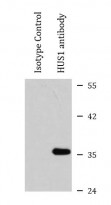ARG58859
anti-HUS1 antibody
anti-HUS1 antibody for ICC/IF,Immunoprecipitation,Western blot and Human,Mouse
Overview
| Product Description | Rabbit Polyclonal antibody recognizes HUS1 |
|---|---|
| Tested Reactivity | Hu, Ms |
| Tested Application | ICC/IF, IP, WB |
| Host | Rabbit |
| Clonality | Polyclonal |
| Isotype | IgG |
| Target Name | HUS1 |
| Antigen Species | Human |
| Immunogen | Recombinant fusion protein corresponding to aa. 1-280 of Human HUS1 (NP_004498.1). |
| Conjugation | Un-conjugated |
| Alternate Names | hHUS1; Checkpoint protein HUS1 |
Application Instructions
| Application Suggestion |
|
||||||||
|---|---|---|---|---|---|---|---|---|---|
| Application Note | * The dilutions indicate recommended starting dilutions and the optimal dilutions or concentrations should be determined by the scientist. | ||||||||
| Positive Control | 293T | ||||||||
| Observed Size | 35 kDa |
Properties
| Form | Liquid |
|---|---|
| Purification | Affinity purified. |
| Buffer | PBS (pH 7.3), 0.02% Sodium azide and 50% Glycerol. |
| Preservative | 0.02% Sodium azide |
| Stabilizer | 50% Glycerol |
| Storage Instruction | For continuous use, store undiluted antibody at 2-8°C for up to a week. For long-term storage, aliquot and store at -20°C. Storage in frost free freezers is not recommended. Avoid repeated freeze/thaw cycles. Suggest spin the vial prior to opening. The antibody solution should be gently mixed before use. |
| Note | For laboratory research only, not for drug, diagnostic or other use. |
Bioinformation
| Database Links | |
|---|---|
| Gene Symbol | HUS1 |
| Gene Full Name | HUS1 checkpoint clamp component |
| Background | The protein encoded by this gene is a component of an evolutionarily conserved, genotoxin-activated checkpoint complex that is involved in the cell cycle arrest in response to DNA damage. This protein forms a heterotrimeric complex with checkpoint proteins RAD9 and RAD1. In response to DNA damage, the trimeric complex interacts with another protein complex consisting of checkpoint protein RAD17 and four small subunits of the replication factor C (RFC), which loads the combined complex onto the chromatin. The DNA damage induced chromatin binding has been shown to depend on the activation of the checkpoint kinase ATM, and is thought to be an early checkpoint signaling event. Alternative splicing results in multiple transcript variants. [provided by RefSeq, Feb 2011] |
| Function | Component of the 9-1-1 cell-cycle checkpoint response complex that plays a major role in DNA repair. The 9-1-1 complex is recruited to DNA lesion upon damage by the RAD17-replication factor C (RFC) clamp loader complex. Acts then as a sliding clamp platform on DNA for several proteins involved in long-patch base excision repair (LP-BER). The 9-1-1 complex stimulates DNA polymerase beta (POLB) activity by increasing its affinity for the 3'-OH end of the primer-template and stabilizes POLB to those sites where LP-BER proceeds; endonuclease FEN1 cleavage activity on substrates with double, nick, or gap flaps of distinct sequences and lengths; and DNA ligase I (LIG1) on long-patch base excision repair substrates. The 9-1-1 complex is necessary for the recruitment of RHNO1 to sites of double-stranded breaks (DSB) occurring during the S phase. [UniProt] |
| Cellular Localization | Nucleus, Cytoplasm. [UniProt] |
| Calculated MW | 32 kDa |
Images (3) Click the Picture to Zoom In
-
ARG58859 anti-HUS1 antibody ICC/IF image
Immunofluorescence: U2OS cells stained with ARG58859 anti-HUS1 antibody.
-
ARG58859 anti-HUS1 antibody WB image
Western blot: 25 µg of 293T cell lysate stained with ARG58859 anti-HUS1 antibody at 1:1000 dilution.
-
ARG58859 anti-HUS1 antibody IP image
Immunoprecipitation: 200 µg extracts of 293T cells were immunoprecipitated and stained with ARG58859 anti-HUS1 antibody at 1:1000 dilution.








